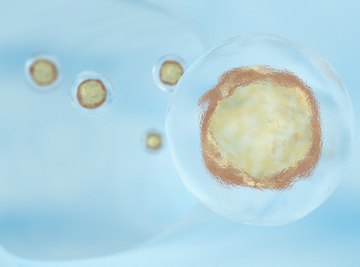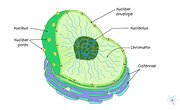
The often-cited "central dogma of molecular biology" is captured in the simple scheme DNA to RNA to protein. Slightly expanded, this means that the deoxyribonucleic acid, which is the genetic material in the nucleus of your cells, is used to make a similar molecule called RNA (ribonucleic acid) in a process called transcription. After this is done, RNA is used to direct the synthesis of proteins elsewhere in the cell in a process called translation.
Every organism is the sum of the proteins it makes, and in everything alive today and ever known to have lived, the information for making these proteins is stored in, and only in, that organism's DNA. Your DNA is what makes you what you are, and is what you pass on to any children you may have.
In eukaryotic organisms, after the first step of transcription is complete, the newly synthesized messenger RNA (mRNA) must find its way outside the nucleus into the cytoplasm where translation takes place. (In prokaryotes, which lack nuclei, this is not the case.) Because the plasma membrane surrounding the contents of the nucleus can be choosy, this process requires active input from the cell itself.
Nucleic Acids
Two nucleic acids exist in nature, DNA and RNA. Nucleic acids are macromolecules as they are composed of very long chains of repeating subunits, or monomers, called nucleotides. Nucleotides themselves consist of three distinct chemical components: a five-carbon sugar, one to three phosphate groups, and one of four nitrogen-rich (nitrogenous) bases.
In DNA, the sugar component is deoxyribose, whereas in RNA it is ribose. These sugars differ only in that ribose carries a hydroxyl (-OH) group attached to a carbon outside the five-membered ring where deoxyribose carries only a hydrogen atom (-H).
The four possible nitrogenous bases in DNA are adenine (A), cytosine (C), guanine (G) and thymine (T). RNA has the first three, but includes uracil (U) in place of thymine. DNA is double-stranded, with the two strands linked at their nitrogenous bases. A always pairs with T, and C always pairs with G. The sugar and phosphate groups create the backbone" of each so-called complementary strand. The resulting formation is a double helix, the shape of which was discovered in the 1950s.
- In DNA and RNA, each nucleotide contains a single phosphate group, but free nucleotides often have two (e.g., ADP, or adenosine diphosphate) or three (e.g., ATP, or adenosine triphosphate).
Synthesis of Messenger RNA: Transcription
Transcription is the synthesis of an RNA molecule called messenger RNA (mRNA), from one of the complementary strands of a DNA molecule. There are other types of RNA as well, the most common being tRNA (transfer RNA) and ribosomal RNA (rRNA), both of which play critical roles in translation at the ribosome.
The purpose of mRNA is to create a mobile, encoded set of directions for the synthesis of proteins. A length of DNA that includes the "blueprint" for a single protein product is called a gene. Each three-nucleotide sequence carries the instructions for making a particular amino acid, with amino acids being the building blocks of proteins in the same way nucleotides are the building blocks of nucleic acids.
There are 20 amino acids in all, allowing for an essentially limitless number of combinations and hence protein products.
Transcription occurs in the nucleus, along a single strand of DNA that has become uncoupled from its complementary strand for purposes of transcription. Enzymes become attached to the DNA molecule at the start of the gene, notably RNA polymerase. The mRNA that is synthesized is complementary to the DNA strand used as a template, and thus resembles the template strand's own complementary DNA strand except that U appears in mRNA wherever T would have appeared were the growing molecule DNA instead.
mRNA Transport Within the Nucleus
After mRNA molecules are synthesized at the transcription site, they must make their journey to the sites of translation, the ribosomes. Ribosomes appear both free in the cell cytoplasm and attached to a membranous organelle called the endoplasmic reticulum, both of which lie outside the nucleus.
Before the mRNA can pass through the double plasma membrane that makes up the nuclear envelope (or nuclear membrane), it must reach the membrane somehow. This occurs by the binding of the new mRNA molecules to transport proteins.
Before the resulting mRNA-protein (mRNP) complexes can move to the edge, they become thoroughly mixed inside the substance of the nucleus, so that those mRNP complexes that happen to form near the edge of the nucleus have no better a chance at exiting the nucleus at a given time after formation than do mRNP processes close to the interior.
When mRNP complexes encounter regions of the nucleus heavy in DNA, which in this environment exists as chromatin (i.e., DNA bound to structural proteins), it can become stalled, just like a pickup truck being bogged down in heavy mud. This stalling can be overcome by the input of energy in the form of ATP, which prods the bogged-down mRNP in the direction of the edge of the nucleus.
Nuclear Pore Complexes
The nucleus needs to protect the all-important genetic material of the cell, yet it also must have a means of exchanging proteins and nucleic acids with the cell cytoplasm. This is accomplished via "gates" consisting of proteins and known as nuclear pore complexes (NPC). These complexes have a pore running through the double membrane of the nuclear envelope and a number of different structures on either side of this "gate."
The NPC is enormous by molecular standards. In human beings, it has a molecular mass of 125 million Daltons. In contrast, a molecule of glucose has a molecular mass of 180 Daltons, making it about 700,000 times smaller than the NPC complex. Both nucleic acid and protein transport into the nucleus and the movement of these molecules out of the nucleus occur via the NPC.
On the cytoplasmic side, the NPC has what is called a cytoplasmic ring as well as cytoplasmic filaments, both of which serve to help anchor the NPC in place in the nuclear membrane. On the nuclear side of the NPC is a nuclear ring, analogous to the cytoplasmic ring on the opposite side, as well as a nuclear basket.
A variety of individual proteins participate in the movement of mRNA and a diverse variety of other molecular cargoes out of the nucleus, with the same applying to movement of substances into the nucleus.
mRNA Function in Translation
mRNA does not begin its actual job until it reaches a ribosome. Each ribosome in the cytoplasm or attached to endoplasmic reticulum consists of a large and a small subunit; these only come together when the ribosome is active in transcription.
When an mRNA molecule becomes attached to a translation site along the ribosome, it is joined by a particular kind of tRNA that carries a specific amino acid (there are therefore 20 different flavors of tRNA, one for each amino acid). This occurs because the tRNA can "read" the three-nucleotide sequence on the exposed mRNA that corresponds to a given amino acid.
When the tRNA and mRNA "match up," the tRNA releases its amino acid, which is added to the end of the growing amino acid chain destined to become a protein. This polypeptide reaches its specified length when the mRNA molecule is read in its entirety, and the polypeptide is released and processed into a bona fide protein.
References
- LibreTexts Biology: Nucleic Acids
- LibreTexts Biology: Transcription
- NIH Center for Molecular Modeling and Bioinformatics: The Nuclear Pore Complex
- Scitable By Nature Education: Exporting RNA from the Nucleus to the Cytoplasm
- Proceedings of the National Academy of Sciences: Mechanism of mRNA Transport in the Nucleus
- NCBI Bookshelf - Molecular Biology of the Cell (4th Edition): The Transport of Molecules between the Nucleus and the CytosolMechanism of mRNA transport in the nucleus
About the Author
Kevin Beck holds a bachelor's degree in physics with minors in math and chemistry from the University of Vermont. Formerly with ScienceBlogs.com and the editor of "Run Strong," he has written for Runner's World, Men's Fitness, Competitor, and a variety of other publications. More about Kevin and links to his professional work can be found at www.kemibe.com.
